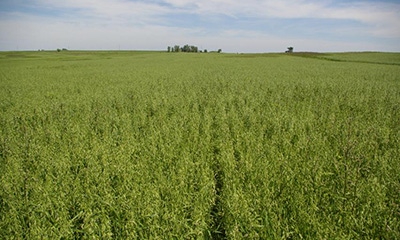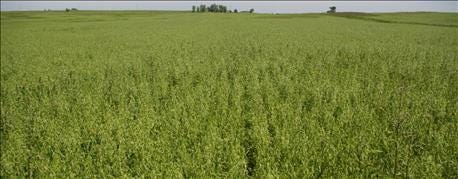April 4, 2016

It’s time to plant small grains. When planting oats, spring wheat and barley, farmers typically plant 2 to 3 bushels of small grains per acre, but there is a better way to optimize plant populations and grain yields. Farmers calculate corn and soybean rates by seed count and should do the same for small grains, says Margaret Smith, Iowa State University Extension specialist in value added agriculture. Smith, along with Mary Weidenhoeft, ISU professor of agronomy, and David Weisberger, an ISU graduate student in agronomy, provide the following information and guidelines.

GROWING OATS: More farmers are looking to decrease their input costs by adding a third crop to their corn and soybean rotation. Taking advantage of a longer rotation depends at least somewhat on having a market for the small grain crop.
Aim for the right plant stand. When planting oats, barley or wheat, work to achieve harvest plant populations of 1 million to 1.3 million plants per acre or approximately 22 to 29 plants per square foot. Several factors affect final plant stands at oat harvest including: desired final plant stand, number of oat seeds per pound, germination rate in the seed lot, and expected stand loss from irregular seeding depth or early plant death.
Calculate your seeding rate: Calculating seeding rates in terms of seeds per acre rather than bushels will improve your planting accuracy and help to optimize yields. Oat bushels are standardized at 32 pounds per bushel, though there is a range of actual test weights. In addition, seed number varies per pound depending on oat cultivar and the growing conditions under which the seed was produced.
Seed counts for oats can range from 12,000 to 17,000 seeds per pound and are not commonly listed on seed bags. Seed dealers can provide that information if they have an automated seed counter in-house. If seed counts are not readily available, weigh an ounce of seed on a digital kitchen scale, count the seeds per ounce, and multiply that by 16 to calculate seeds per pound.
Account for germination rate: When calculating the actual seed drop rate you will plant, you need to account for the less than 100% germination rate of your seed lot and for stand establishment losses, typically 10% to 20%. This will increase the amount of seed you need to put into the ground at planting. Use the following formula to calculate oat seed drop rate:
1) Determine desired final stand per acre and divide by: (1-expected stand loss).
2) Calculate seeds per pound and multiply by the germination rate of the seed lot.
3) Divide number 1 by number 2 for the final seeding rate.
The Department of Agriculture in Alberta, Canada has developed an online calculator (link: agric.gov.ab.ca/app19/calc/crop/otherseedcalculator.jsp) to determine seeding rates for oats and other small grains. Note that the rates are calculated using grams not ounces. This can be converted by using 28.35 grams per ounce.
If oat or other small grain planting is delayed, less tillering, fewer seed heads per acre, and reduced grain yield will result. The University of Minnesota advises increasing seeding rates by 1% for each day after the optimum spring small grain seeding date to compensate for less tillering.
You May Also Like




